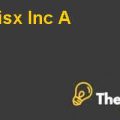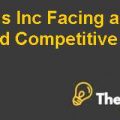Target Corporation Case Study Analysis
In the retail industry, the important ratios are inventory turnover, EPS, profit margin, ROA, current ratios and quick ratios. It could be seen in the table 1 that Inventory turnover, average collection period, free cash flows, EPS, operating margin, profit margin, debt to asset ratio and debt to equity ratios are greater than the industry dynamics. In addition to this, these all ratios are important for the retail industry. Thus, it is concluded that these proposed projects have positive NPV’s along with having increased financialperformance in comparison with the industry measures. It is recommended that these projects should be considered because of the above discussed assumptions.
Recommendations
The CFO of Target Corporation, Doug Scovanner was analyzing the potential long-term and short-term benefits associated with the listed 10 new projects.The NPVs of the five projects was representing a positive outcome and would be considered as the better option in comparison with other.These 10 projects were representing a total of $300 million capital investment, while the five projects, having small NPVs, were representing a total capital investment of $200 million. Scovanner has to analyze which projects are best and should be plotted at top ranks with respect to its associated risk and return level. In addition to this, the selected projects should meet the expected company’s growth level. Wall Mart was a global retailing company along with generating approximately $309 billion of sales, for the year 2005, and owning 4,189 stores globally. Everyday low pricing strategy and branching of product line strategy was adopted by Wall Mart in order to capture number of customers. On the other hand, Costco was a low profit margin business, which adopted a discounted pricing strategy in the form of membership fee.
The project’s rejection or acceptance has been depend on some strategic evaluation, which included determining the financial measure, discounted cash flows, NPV, IRR, total investment size, EPS and projected profits along with determining the overall impact on the total sales and nearby stores. In the retail industry, the important ratios are inventory turnover, EPS, profit margin, ROA, current ratios and quick ratios. Thus, it is concluded that these proposed projects have positive NPV’s along with having increased financial performance in comparison with the industry measures. It is recommended that these projects should be considered, because of the above discussed assumptions.
Conclusion
It is concluded Scovanner was analyzing the potential long-term and short-term benefits associated with the listed 10 new projects. By the end of 2005, he succeeded to establish a powerhouse retail chain by targeting 47 stores with the inclusion of 1,397 stores, which were generating approximately $52.6 billion revenues. In the retail industry, the competition was high because of number of sellers, who was selling the same line of product as compared with the Target Corporation. Walmart was imposing a high threat because of similar business model and merchandizing assortments as compared with Target Corporation.In the retail industry, the important ratios are inventory turnover, EPS, profit margin, ROA, current ratios and quick ratios. Thus, it is concluded that these proposed projects have positive NPV’s along with having increased financial performance in comparison with the industry measures. It is recommended that these projects should be considered because of the above discussed assumptions................................
This is just a sample partical work. Please place the order on the website to get your own originally done case solution.











